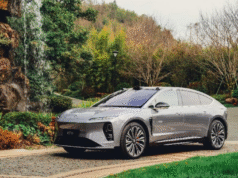
While the West deliberates, China accelerates.
In the year leading up to October 2025, three bestselling Chinese electric-vehicle brands — BYDBYDBYD Auto is a Chinese carmaker that became the world’s leading EV manufacturer in 2023, competing with Tesla for market share and global attention.READ MORE, Wuling, and Geely — received approvals for 83 new passenger car models collectively in the world’s largest EV market, according to China’s Ministry of Industry and Information Technology. Volkswagen was approved for six, and Nissan for two.
BYD and Tesla — among the top-selling brands globally — got the go-ahead for 38 and three cars, respectively, in China. The ministry’s list includes existing models with slight updates and completely new cars made in China.
The pace of launches shows how Chinese automakers have turned speed into their greatest advantage, releasing new cars faster than competitors can finish designing them. Their grip on sales supply chains, raw material access, and innovation has allowed them to set the pace of the global EV industry’s evolution.
“When your lineup is younger, you have more chances of selling more cars,” Felipe Munoz, founder of industry research platform Car Industry Analysis, told Rest of World. “A new car is always an opportunity for any carmaker to catch up.”
On the global scale, the Volkswagen Group — including brands like Audi and Porsche — introduced around 50 new electric passenger cars between January 2024 and October 2025, a company spokesperson told Rest of World. “Around 30 of those have a Plug-In Hybrid powertrain and around 20 are all-electric vehicles. … We do not disclose a detailed model list for the global scope,” the spokesperson said in response to an email query.
Chinese EV models reach the market two to three years faster than non-Chinese brands, according to a 2024 report by New York-based consulting firm AlixPartners. Chinese EV firms typically take 20 months to develop a new car, compared with 40 months for Chinese legacy carmakers.
China’s high EV penetration drives its rapid development cycle, Yichao Zhang, an automotive practice partner at AlixPartners, told Rest of World. EVs account for half of all new car sales in China, compared to only about 20% in Europe and less than 10% in the U.S.
“In the past years, many new brands and models went into the market, which forced existing players to accelerate the product update frequency,” Zhang said.
Mounting competition within China is forcing every company to move faster or face extinction.
China’s EV market currently has 129 brands, and by 2030, more than 100 of those will have disappeared, AlixPartners said.
Chinese car brands accounted for 91 of the 180 new cars released globally from November 2024 to October 2025, including EVs, gasoline vehicles, and all passenger cars and light trucks, according to Munoz’s count of new car models, excluding restyling and facelifts.
“Despite different definitions, the Chinese are still ahead,” Munoz said. “The model launch and pace between Chinese carmakers and traditional ones from other countries are quite big.”
The speed advantage stems from China’s dominance across the EV supply chain. It controls rare earth materials, battery production, and, according to the International Energy Agency, accounts for 70% of the world’s EVs production.
Chinese brands achieve their efficiency through fixed supplier relationships that cut sourcing and styling time, Mark Reuss, president of General Motors, acknowledged in a recent interview with online publication InsideEVs.
“We can learn a lot from the speed,” Reuss said on InsideEVs’ Plugged-In podcast, while discussing lessons learned from running joint ventures in China.
Foreign companies operating in China have started treating the market as a laboratory for learning these methods, Elvis Yang, general manager of auto product practice at J.D. Power China, told Rest of World. They conduct research and development based on Chinese partners’ mature EV platforms, and source from suppliers in the country.
Many joint-venture automakers regard the Chinese market as a ‘gym’ to enhance their comprehensive capabilities in EVs.”
“Many joint-venture automakers regard the Chinese market as a ‘gym’ to enhance their comprehensive capabilities in EVs,” Yang said. “After gaining experience here, they then expand to other regions around the world.”
Chinese EV makers, for their part, are ramping up overseas expansion to offset the low margins resulting from domestic price wars. In just the first 10 months of 2025, China shipped 2 million EVs, a 90% jump from a year earlier.
As Chinese EV makers increase their presence in global markets, their speed in updating models has brought them into direct competition with established automakers.
EV makers in the U.S. currently avoid this competition as tariffs block Chinese EV entry to the market. Chinese companies are exploring building factories in Mexico and other countries with trade agreements that could bypass these barriers.
Still, speed alone won’t guarantee success in every market, experts told Rest of World. Consumer preferences and competitive landscapes vary significantly across countries, and rushed development can compromise safety testing and the uniqueness of the designs.
“The consumer preferences and current competition landscape are quite different from each other,” Zhang said. “The compromise when adopting this strategy is the trade-off to thorough quality check, especially on safety, and unique exterior design.”
U.S. automakers will need to compete through research and investment in technology rather than attempting to match production speed, according to Reuss.
“At the end of the day … the R&D technology investment in our company, in this country, is the way to compete,” Reuss said in his podcast interview. “We can’t copy the way they do things and expect to win.”








